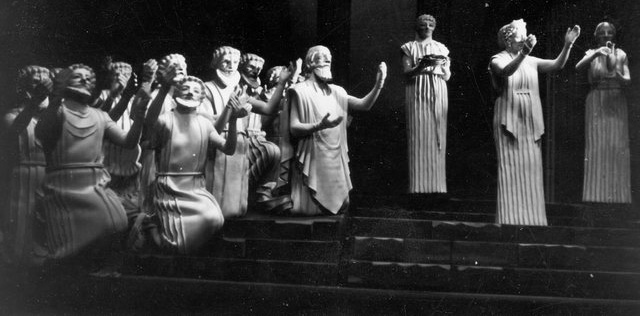Juozas Miltinis was a talented diplomat. He understood that the right to an excellent, intelligent and serious theatre bore a high price, one that he paid regularly, time and again staging "correct" (i.e. hopelessly dismal and monotonous) Soviet productions. Their presentation protected the true theatre beneath, one that spoke in the literary words of the world's classics, confronted the most painful questions of human existence and employed the tools of modern stagecraft.
The voice of this theatre was first heard before Miltinis even officially assumed his duties in Panevėžys, with the production (under his secret direction) of Ibsen's Hedda Gabler in 1957, and Death of a Salesman in 1958, the first staging of the Arthur Miller play anywhere in the Soviet Union. These two productions gave an early demonstration of Miltinis' unique ability to examine complex, multifaceted and paradoxical characters. The director was able to liberate himself from the inertia of the representation of a socialized man, and concentrate his vision on the reality of man's individual consciousness, to introvert and intellectualize the person in his own way. He penetrated deeply in search of the sensitive nerve of human existence: the "tangle of extremes" raging through the soul of Hedda Gabler (played by Eugenija Šulgaitė), Marijana Malcienė, „Panevėžio dramos teatras“, in: Lietuvių tarybinis dramos teatras: 1957–1970, sudarė Algirdas Gaižutis, Vilnius: Vaga, 1987, p. 244. or the suffocating, impenetrable inner contradictions of Willy Loman (Donatas Banionis), rooted "in the deepest labyrinths of psychology, consciousness and subconsciousness," in Death of a Salesman. Markas Petuchauskas, Donatas Banionis, Vilnius: Mintis, 1976, p. 44.
At the end of the 1950s, Miltinis debuted as a director examining the contradictory and inexplicable nature of modern consciousness. This theme was explored with full force in the "golden" productions staged at the Panevėžys Drama Theatre in the 1960s that transformed the city into one of the theatrical capitals of the Soviet Union: Chekhov's Ivanov (1960), Shakespeare's Macbeth (1961), and Wolfgang Borchert's The Man Outside (Draußen vor der Tür) in 1966. This was the start of what would become the phenomenon of Lithuanian theatre, an idea that was solidified by other Lithuanian stage giants, and expanded upon internationally.
In a certain sense, these different productions together comprised a trilogy. Most likely they were connected primarily by Miltinis' existentialist burden: they resonated as variations of the same existentialist theme of man's infinite loneliness in a cold, alienated world. Expanding on this theme with each production, Miltinis increasingly refined, emptied and increased the austerity of his stagings, until he was finally left with sets using only lighting effects and music, revealing and baring his hero like a surgeon using a scalpel to penetrate into the the deepest layers of the hero's consciousness, sketching out its ever more complex webs. Miltinis constantly sought out opportunities for effective forms of expressing on stage the portrait of a self-injured hero, trapped and lost within himself.
His main creative instrument, however, remained the same: the essential creative material of the productions themselves, whose most important reason for success was the exceptional quality of the acting: extraordinary realism, naturalness and simplicity accompanied by a presence on stage that demonstrated an almost impossible internal tension and precision. This allowed the actors to penetrate the aching and shocking resonance of the tragedy of splintered, fragile, and discordant souls, tired even of themselves, that so fascinated Miltinis. Stasys Petronaitis portrayed Ivanov as "outwardly modest and thoughtful" but internally infinitely "fragile, vulnerable and dramatic". Marijana Malcienė, „Panevėžio dramos teatras“, in: Lietuvių tarybinis dramos teatras: 1957–1970, sudarė Algirdas Gaižutis, Vilnius: Vaga, 1987, p. 255. Petronaitis later embodied Macbeth as inflicted by "internal contradictions" or persistent "spiritual crises", Dovydas Judelevičius, Gyvasis Šekspyras, Vilnius: Vaga, 1964, p. 152. committing ever more brutal crimes and thereby increasing his own suffering and self-loathing, while Donatas Banionis' Beckman in The Man Outside was a man experiencing "the stages of tragic disappointment like Dante's circles of hell" Markas Petuchauskas, Donatas Banionis, Vilnius: Mintis, 1976, p. 69. and suffering silently through the entirety of his own horrible memories, a reproachful conscience, nightmarish visions and hallucinations, and a monstrous loneliness.




Comments
Write a comment